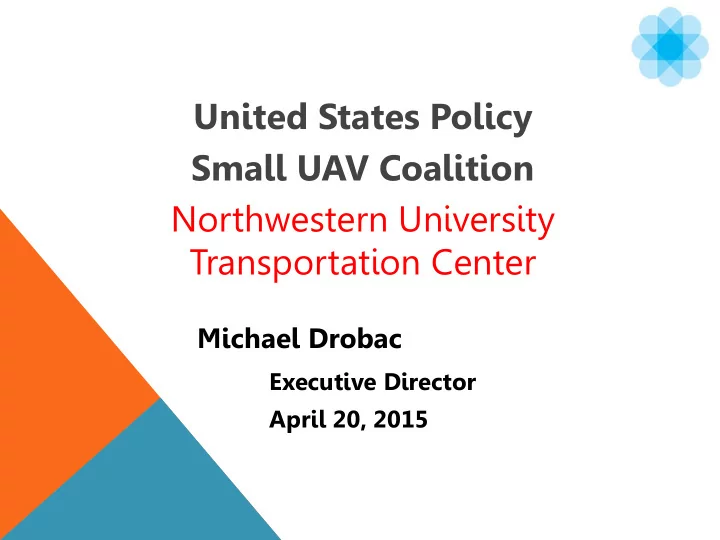

United States Policy Small UAV Coalition Northwestern University Transportation Center Michael Drobac Executive Director April 20, 2015
1 www.smalluavcoalition.org
SOME OF OUR MEMBERS 2 www.smalluavcoalition.org
OUR OBJECTIVES • Promote the safe commercial, civil, and philanthropic use of small UAVs. • Demonstrate the important economic, environmental, and public safety benefits of small UAVs. • Develop a sensible, efficient, and open regulatory process to ensure the timely introduction and operation of small UAVs. • Support domestic and international UAV operations in the United States. 3 www.smalluavcoalition.org
CURRENT STATUS OF COMMERCIAL UAVS • Commercial Use of UAVs currently illegal • NPRM (Notice of Proposed Rule Making) released February 15th • Section 333 Exemption Process • Legislative change • Federal Aviation Administration Reauthorization 2015 • State Activity – Federal Preemption? 4
SCOPE OF SUAS RULEMAKING & RULEMAKING PROCESS Addresses only small UAVs – no heavier than 55 pounds, • with payload Does not address operation of UAVs by modelers and • hobbyists Comments due by April 24, 2015 • Final rule not expected until 2016-17 • Section 333 exemption process provides only avenue • for commercial operation of UAVs until final rule is effective Unless Congress steps in • 5
RESTRICTIONS IN PROPOSED RULE • Operations limited to within visual line of sight of the operator • Operations limited to daylight hours • Requires 3 miles of flight visibility • Operations may not be conducted over any person not directly involved with the operation • Operations in any controlled airspace (proximity to airports) require ATC permission • UAVs must yield to manned aircraft 6
SEC 333 EXEMPTIONS PRESS BRIEFING Referred to November 7, 2013 “Integration of Civil Unmanned Aircraft Systems (UAS) in the National Airspace System (NAS) Roadmap” flagging integration would be a slow process but recognizing integration cannot wait for systems perfection: “Ultimately, UAS must be integrated into the NAS without reducing existing capacity, decreasing safety, negatively impacting current operators, or increasing the risk to airspace users or persons and property on the ground any m more t than the i integration of c comparable new and novel el t tec echnologies es .” (Emphasis supplied.) 7
Multi-rotor Aircraft 8
KEY ISSUES IN THE UNITED STATES Altitude and airspace • Duration of flight • Kinetic energy (Speed + Weight) • Line of sight • Certification of aircraft • Capability of UAV • Area of operations • Communications capability • Operator certification • Sense and Avoid • 9
WHAT WE’RE DOING 10 www.smalluavcoalition.org
FINAL THOUGHT Technology Always Wins. 11 www.smalluavcoalition.org
CONTACT US mdrobac@akingump.com @smalluavs www.smalluavcoalition.org 12 www.smalluavcoalition.org
Recommend
More recommend